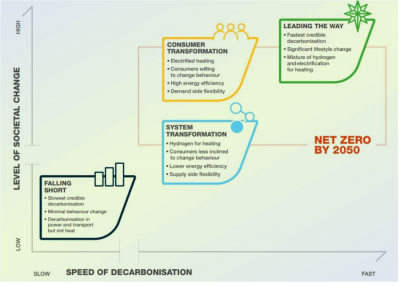A beginner's journey into DIY home energy storage - no solar!
It's worthwhile reading the submission by National Grid ESO to the Commons Select Committee on Energy from Sept'23:
"To achieve net zero targets, our scenario modelling shows capacities of longer duration storage technologies of 3 to 9 GW in 2030, rising to 12 to 17 GW in 2050."
They also extend the definition of Long-term Storage to beyond the 200hr figure which has previously been used.
And they see a need for hydrogen-generation to be developed as 'storage' to at least 18GW by 2050.
One issue I have with their projections is that it is firmly based on the System Transformation option, as defined in the Future Energy Scenarios.
They assume that the contribution from the general public (Consumer Transformation) will negligible.
The System Transformation model is the most expensive option for us consumers because we are required to pay for it.
It's important for us to note that the outcome of implementing storage batteries by end-users is different to the large scale commercial batteries which @david999 mentions.
When us consumers install batteries in the home, the effect is to dramatically reduce peak-time demand.
Reducing the peak has a wide-reaching corollary on the grid.
The requirement to upgrade grid capacity is significantly diminished... and thus less of our money is needed.
In contrast, commercial battery storage has no effect on peak demand.
It merely allows the network operator, ISOP, to fill in the gaps when the sun doesn't shine or the wind doesn't blow.
The massive grid upgrades are still required.
Save energy... recycle electrons!
Any update on this? Is your DIY battery storage system connected and working yet? Also have you considered the Octopus Agile tariff which gives you wholesale electricity prices for the next 24 hours? Might be a way to maximize the savings from your system?
Hiya @mike_r1958 - and thanks for your interest. I've had battery storage systems 'working' for 5 years.
But that doesn't mean the equipment is in a state where it could simply be replicated by others.
For example, one of the inverters currently has a fault which prevents solar input.
The fault condition was properly displayed on its integral LCD.
However:
- it didn't fail 'safe' in that it continued to take current from the solar panels through a damaged section of electronics
- the fault code isn't reported across Modbus to our smart controller
I don't think that's a situation which would be acceptable for wider deployment.
I could smell the fried electronics and then use the monitoring on that solar-panel array to work out what was happening.
But solar arrays aren't usually connected to instrumentation, and most members of the public wouldn't know enough to realise that they needed to be manually isolated from the inverter.
Yes, we're well aware of the several Octopus ToU tariffs and the cost savings available on each.
However, in this location those tariffs don't provide a fair reflection of the state of the grid.
It is often the case that excess generation is being discarded in SW England, whilst the national grid is experiencing high demand.
That means the Agile price will be high, acting as a disincentive to recharge the batteries.
Nodal pricing for consumers may have been dismissed by the previous Secretary of State for ESNZ on 12th March, but that was a political decision, rather than one based on science.
You will appreciate that development work on smart control technology must be built on the underlying physics, regardless of what government thinks!
If you'd like to see a more recent example of government proposals ignoring science, have a look at what I wrote here about Demand Side Response in the public consultation "Delivering a Smart and Secure Electricity Grid".
What is being developed here is technology which can respond to more than price.
We are picking up data from transformers operated by National Grid, and their forward projections of which sources of generation will be contributing in the coming hours.
Thus, an end-user could configure the controller to say that they'd like the battery to be recharged from the grid during the cheaper periods, but they'd be prepared to take a slightly higher price-band if the proportion of a certain energy source was lower.
That allows the system to be tuned to import less electricity from nuclear-energy or gas-fired generation for example.
I can illustrate that by representing energy sources as a triangle:
It's not strictly accurate because the National Grid data we receive has over 20 categories.
But the crude triangle reflects the bias which exists in society for & against particular energy sources.
Now place that triangle flat on the desktop and imagine a third vertical axis for price:
The floating yellow triangle represents my personal preferences.
I can tilt it to reflect how much I'm prepared to pay in order to receive a bias in favour of renewable energy sources for example.
What I've just shown you isn't part of the user interface on the smart controller.
It's merely illustrative of how the internal algorithms operate to facilitate preferences beyond price.
If we only apply electricity price factors as the mechanism to combat Climate Change, then I regret we will fail.
Save energy... recycle electrons!
@transparent my opinion is that change can be brought about in two ways. Firstly by force, the fossil fuel prices increase until alternatives present as the best options. Secondly, by making the alternatives less expensive. The first option forces those who can switch but some can’t afford it and others are not suitably located, and some technology will still require to run fossil fuels for some time as it evolves. Aircraft, ships, trains and trucks etc. I’m guessing as demand reduces then production reduces and production costs increase. I have a heat pump, solar PV, solar thermal, and a hybrid car, charging point goes in next week. I only get 30 miles on battery alone but it meets my needs bring retired and if I’m honest far from where we need to be. I have a drive where I can charge my vehicle but most do not. A large number of houses are not suitable for heat pumps both from insulation requirements which would be impractical and a location to place the equipment in the house since a large number of houses can site a combi boiler but no space for a cylinder. Lofts are mostly non load bearing and the hatch too small to get a cylinder through.
lastly on that subject is the skill set to take it forward, my installation was a train wreck and nearly 9 months of battle to get it sorted. I doubt garages are up to speed on Ev cars either.
on a separate note can anyone tell me if it’s easy to add more panels. I have one string producing 2.6 and growatt say I have plenty capacity to add more. I have spare plugs for my inverter and an additional socket where I presume I could plug another string in but not sure if it needs configured and if I need to inform my power supplier.
Any advice appreciated and what panels to opt for. I intend to fit them to my garage roof which has 9x3 inch joists with a box section steel roof. Easy access to run the cable into the house.
Posted by: @david999on a separate note can anyone tell me if it’s easy to add more panels.
Yes... but it's marginally more difficult if you start in a topic about battery storage with the words "no solar" in the title. 😉
Start by looking at the spec for your Growatt inverter.
Check that it supports two independent PV arrays.
Look at the voltage range over which you can use that PV input port (typically 100-450v)
Then look at the voltage range over which the MPPT algorithm will operate (typically somewhat narrower, at around 150-420v)
Then create a separate topic to post those results, using a title which other DIY solar panel installers will gravitate towards!
Save energy... recycle electrons!
@transparent will do, I hoped someone would upgrade me but when I enquire they are only interested is a whole system install and fairly unhelpful.
- 26 Forums
- 2,357 Topics
- 53.5 K Posts
- 175 Online
- 6,025 Members
Join Us!
Worth Watching
Latest Posts
-

RE: Setback savings - fact or fiction?
I could, but I think we can do better, by plotting hour...
By cathodeRay , 8 hours ago
-
RE: Midea ASHP – how to set weather compensation
Just one more thought. If you have convenient space fo...
By JamesPa , 10 hours ago
-
RE: Advice on internal circulation pump noise
Extend the primary branch and make sure you have more t...
By ASHP-BOBBA , 11 hours ago
-

RE: External pipework insulation
Oh Dear! that's appalling pipe work, should've been in ...
By dgclimatecontrol , 16 hours ago
-

RE: Jokes and fun posts about heat pumps and renewables
By Morgan , 16 hours ago
-

RE: Controlling Daikin Altherma via P1P2 and Home Assistant
On the contrary, @toodles, that’s a lot of help. I’d ne...
By Majordennisbloodnok , 18 hours ago
-
RE: Octopus Cosy Heat Pump Owners & Discussion Thread
@kevh with the Cosy 6 I know it definitely goes to arou...
By HarrisonC , 1 day ago
-

Parsnip, Bacon & Coconut Milk Soup
First let me say, I am only a cook because I am human a...
By Toodles , 1 day ago
-
RE: Electricity price predictions
Ben Watts posted on LinkedIn that he had updated this w...
By Judith , 2 days ago
-

RE: The good, the bad and the not that great – my heat pump installation
Small update, Emailed and Spoke to Midea UK and they ...
By Burtis , 2 days ago
-
RE: Solis S6-EH1P8K-L-PLUS – Why I Chose It and What I’ve Learned So Far
@bash Octopus does charge for the admin. The process al...
By Batpred , 2 days ago
-
RE: New Fogstar 15.5kWh upright solution
Issues still under investigation by Solis... Fogstar ...
By Batpred , 2 days ago
-
RE: Who's your electricity provider and what's your tariff?
I agree, the consumer is not being properly represented...
By Batpred , 2 days ago
-

RE: Heat Pump Heats the House… But It’s Not Cosy. Emitter Changes or System Tweak?
@toodles interesting suggestion, thanks. I will try to...
By GrahamF , 2 days ago
-
RE: Mitsubishi Ecodan Auto Adaption trial to stop cycling.
The interval you talk of, i think, will be 60min for an...
By F1p , 2 days ago
-
Agree with @majordennisbloodnok on the setbacks. We hav...
By ChandyKris , 3 days ago
-

RE: Speedcomfort radiator fans
@deltona the way the links were added broke the page. A...
By Mars , 3 days ago
-

RE: Refrigerant R32, is it now banned in the EU from 1st Jan 2027 for monobloc ASHPs?
This has been delayed from what I believe to be this ye...
By dgclimatecontrol , 3 days ago







